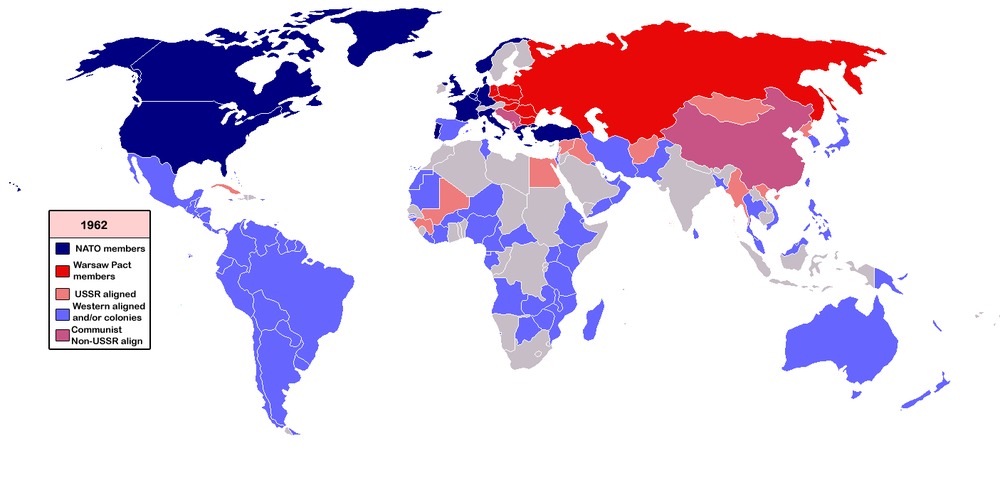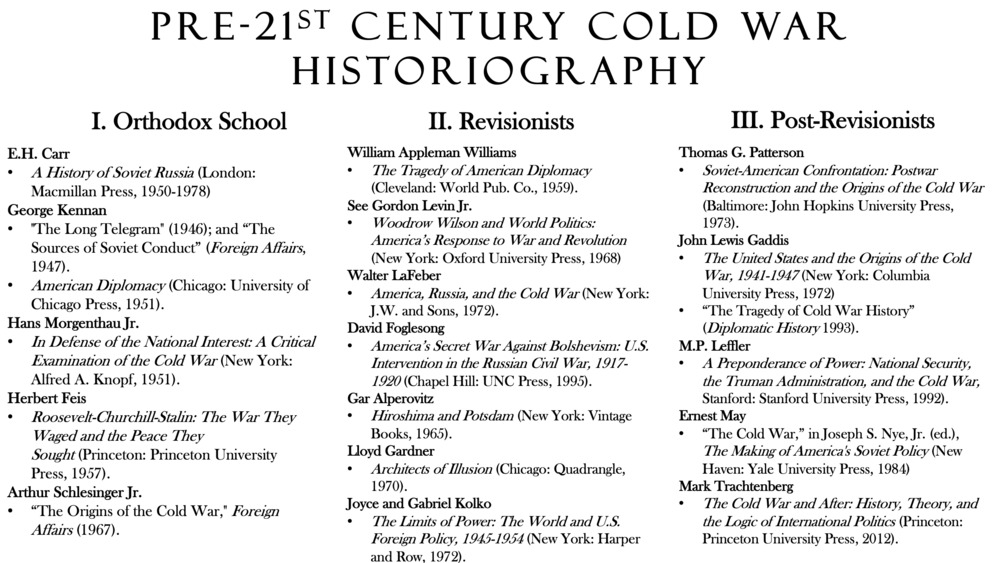A Tale of Two Nations: The Evolution of Cold War Historiography
A Long Way to the Past
The historiography on the Cold War has been in constant flux since the 1950s. As such, many schools of thought have developed as a result to account for the divergining opinions between historians across time.
In order to understand the "Cold War lens" and how, in turn, to reframe it, we must first ultimately explore how the Cold War has been interpreted by specialists. From where did the "Cold War Lens" appear? Three perspectives - covered below - stand out in particular which are fundamental to Cold War studies: the orthodox view, the revisionist view, and the post-revisionist view.
I. The 'Orthodox' Perspective
The Cold War generated two often distinct battles, explains historian Jonathan Nashel:
- The struggle between Western liberal democracy; and,
- The continuing battles among historians…as to the origins and nature of, as well as the blame for, the Cold War [1].
It is important to keep in mind that the original historians of the Cold War – those who represent the “orthodox” perspective – were writing amidst the conflict; they did not possess the same luxury of hindsight as did their successors. As such, early interpretations of the Cold War were vast in scope yet alike in content.
Consider, for instance, E.H. Carr’s remarkable 14-volume work, A History of Soviet Russia (London: Macmillan Press, 1950-1978), which placed the Soviet Union as the world’s driving progressive force, the United States being thus the principal obstruction preventing the advancement of humanity.[2]
Meanwhile Carr was mounting his defences for the communist world, many American and British historians were conversely trying to paint the American experience as virtuous and sincere.
Beginning with the “Long Telegram” to the State Department, followed afterward by writing as the mysterious and anonymous “Mr. X” in his article “The Sources of Soviet Conduct” (Foreign Affairs, 1947), George F. Kennan established the academic precedent of the Soviet Union as inexorably expansionist, anti-democratic, and thus posed a great threat to the United States and the democratic world. As such, the United States should, in turn, operate on a policy of containment against the Soviets [3].
The orthodox interpretation of the Cold War builds upon Kennan’s containment ideas, including in Kennan’s own 1951 monograph, American Diplomacy (Chicago: University of Chicago Press, 1951) [4]. The more prominent of those who would further this perspective include:
- Hans Morgenthau Jr., In Defense of the National Interest: A Critical Examination of the Cold War (New York: Alfred A. Knopf, 1951), who continues the idea that the United States was facing a new enemy and had to adjust accordingly [5]
- Herbert Feis, Roosevelt-Churchill-Stalin: The War They Waged and the Peace They Sought (Princeton: Princeton University Press, 1957), who unapologetically champions the West while irrationally defacing Soviet Premier Joseph Stalin [6]
- Arthur Schlesinger Jr., “The Origins of the Cold War” (Foreign Affairs, 1967), who furthered Kennan and Morgenthau’s apportioning of Soviet blame [7]
II. Cold War Revisionism
The orthodox view of the Cold War remained the dominant mode of historical thought until the 1960s – and, as we will see, still leaves its mark in various forms to this day. However, beginning in 1959, an alternative method by which to approach the Cold War appeared in the form of William Appleman Williams’ The Tragedy of American Diplomacy (Cleveland: World Pub. Co., 1959). Williams challenged the orthodox interpretation that American actors had always been innocent on the world stage, conversely contending the United States to have always been an empire-building people. This was a stark contrast to the literature which preceded it.[8]
As the revisionist mindset developed behind Williams, it was heavily critiqued by pro-Americanists. Nevertheless, a healthy body of literature followed The Tragedy of American Diplomacy by seeking to position the beginnings of the Cold War prior to the conclusion of the Second World War, holding that it was the American domestic policy of visceral anti-communism dating from the early 20th century and prior that helped to shape American Cold War policy. This includes:
- Gordon Levin Jr., Woodrow Wilson and World Politics: America’s Response to War and Revolution (New York: Oxford University Press, 1968) [9].
- Walter LaFeber, America, Russia, and the Cold War (New York: J.W. and Sons, 1972) [10].
- David Foglesong, America’s Secret War Against Bolshevism: U.S. Intervention in the Russian Civil War, 1917-1920 (Chapel Hill: UNC Press, 1995) [11].
- Denna Fleming, The Cold War and its Origins, 1917-1960 (London: Allen & Unwin, 1961).
- Christopher Lasch, The Agony of the American Left (New York: Vintage, 1968).
Perhaps one of the most notorious Cold War revisionists was Gar Alperovitz, who placed heavy blame on President Truman’s decision to drop the atomic bomb on Japan (Hiroshima and Potsdam, New York: Vintage Books, 1965). In effect, the decision to drop the bomb began the Cold War [12].
Alperovitz’s radical conclusions were more moderately approached by Lloyd Gardner’s Architects of Illusion (Chicago: Quadrangle, 1970) [13], while a harsher indictment of American foreign policy belongs to Joyce and Gabriel Kolko’s The Limits of Power: The World and U.S. Foreign Policy, 1945-1954 (New York: Harper and Row, 1972), wherein they argue that the United States was not necessarily combatting just Soviet influence in particular, but similarly any threat to the American economic and political ethos altogether [14].
III. Post-Revisionism
Into the 1970s until around the fall of the Soviet Union, post-revisionism began to reshape Cold War historiography. The traditionalists and the revisionists diametrically opposed one another, but the post-revisionists sought achieve balance by accepting earlier premises but rejecting their often-radical key conclusions. Thomas G. Patterson’s Soviet-American Confrontation: Postwar Reconstruction and the Origins of the Cold War (Baltimore: John Hopkins University Press, 1973), for instance, concluded both Soviet hostility and American attempts to dominate post-war order as equally culpable [15].
But no reading of Cold War post-revisionist scholarship would be complete without including the seminal text, John Lewis Gaddis’s The United States and the Origins of the Cold War, 1941-1947 (New York: Columbia University Press, 1972), which attempted to hold out for as long as possible from assigning blame. Instead, it sought to better understand the interaction at play between the Americans and Soviets, as well as to reframe the Cold War as a gradual development with the reorientation of American foreign policy occurring in early 1946, not with the Truman Doctrine and Marshall Plan as the orthodox historians initially purported [16].
But make no mistake: the tenor of Gaddis’s argument ultimately considers Soviet aggression into Eastern Europe as the catalyst for the Cold War, albeit from a much less Americanist perspective than his predecessors. Strangely, Gaddis’s position seems to have become more inimical and antagonistic over time; his article, “The Tragedy of Cold War History” (Diplomatic History 1993), is a rather blatant criticism of Williams and the revisionist school in general for their unwillingness to sufficiently indict the Soviet Union [17].
IV. To Modernity
Gaddis’s work has remained at the forefront of Cold War historiography into the 21st century. That is not to say it is without its due criticism; rather, those such as Melvyn P. Leffler almost immediately took to picking Gaddis apart (see A Preponderance of Power: National Security, the Truman Administration, and the Cold War, Stanford: Stanford University Press, 1992). Leffler sought to build upon Gaddis, effectively making him a post-revisionist as well, but changed the debate’s focus from American conceptualizations of morality and imperialism to a more rigorous critique of United States notions of national security.
Whatever the case, Gaddis’s work has stood the test of time and is still taught today. His blending of post-revisionism with orthodox assumptions establishes a series of complicated diplomatic processes between the United States and the Soviet Union as to how the Cold War began, but which all the while never ceases to assign blame, however big or small, to the Soviets.
More recently, a new group of historians into the 21st century have begun to not only challenge Gaddis, the post-revisionists, and the orthodox view, but present a new understanding of the Cold War altogether. One which seeks to remove the "Cold War lens" to more accurately understand the global phenomenon that was the Cold War outside of a Washington-Moscow axis.
-------------------------------------------------------------
[1] Jonathan Nashel, "Cold War (1945-91): Changing Interpretations," in John Whiteclay Chambers II, ed., The Oxford Companion to American Military History (New York: Oxford University Press, 1999), 155.
[2] See E.H. Carr, A History of Soviet Russia (London: Macmillan Press, 1950-1978)
[3] See George Kennan, "The Long Telegram" (1946); and “The Sources of Soviet Conduct” (Foreign Affairs, 1947).
[4] See Kennan, American Diplomacy (Chicago: University of Chicago Press, 1951).
[5] See Hans Morgenthau Jr., In Defense of the National Interest: A Critical Examination of the Cold War (New York: Alfred A. Knopf, 1951).
[6] See Herbert Feis, Roosevelt-Churchill-Stalin: The War They Waged and the Peace They Sought (Princeton: Princeton University Press, 1957).
[7] See Arthur Schlesinger Jr., “The Origins of the Cold War," Foreign Affairs (1967).
[8] See William Appleman Williams, The Tragedy of American Diplomacy (Cleveland: World Pub. Co., 1959).
[9] See Gordon Levin Jr., Woodrow Wilson and World Politics: America’s Response to War and Revolution (New York: Oxford University Press, 1968)
[10] Walter LaFeber, America, Russia, and the Cold War (New York: J.W. and Sons, 1972).
[11] See David Foglesong, America’s Secret War Against Bolshevism: U.S. Intervention in the Russian Civil War, 1917-1920 (Chapel Hill: UNC Press, 1995).
[12] See Gar Alperovitz, (Hiroshima and Potsdam, New York: Vintage Books, 1965).
[13] See Lloyd Gardner, Architects of Illusion (Chicago: Quadrangle, 1970).
[14] See Joyce and Gabriel Kolko,The Limits of Power: The World and U.S. Foreign Policy, 1945-1954 (New York: Harper and Row, 1972).
[15] See Thomas G. Patterson’s Soviet-American Confrontation: Postwar Reconstruction and the Origins of the Cold War (Baltimore: John Hopkins University Press, 1973).
[16] See John Lewis Gaddis, The United States and the Origins of the Cold War, 1941-1947 (New York: Columbia University Press, 1972)
[17] See John Lewis Gaddis, “The Tragedy of Cold War History” (Diplomatic History 1993).
[18] M.P. Leffler, A Preponderance of Power: National Security, the Truman Administration, and the Cold War, Stanford: Stanford University Press, 1992).



